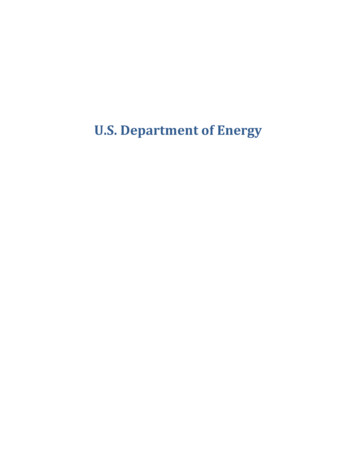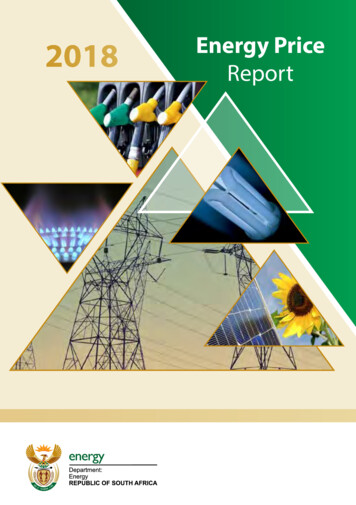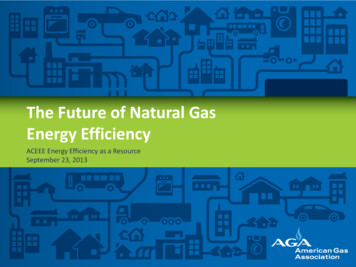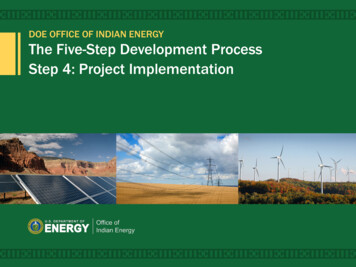
Transcription
U.S. Department of Energy
DEPARTMENT OF ENERGYOffice of the SecretaryBoards & CouncilsSecretary of EnergyAdvisory BoardNational LaboratoryPolicy CouncilEnergy CouncilCredit Review BoardCyber CouncilNuclear Security CouncilJobs CouncilESAABOffice of theUnder Secretary forNuclear Security andNational Nuclear SecurityAdministrationFrank G. KlotzRick PerrySecretaryVacantDeputy Administratorfor Defense NuclearNonproliferationDeputy Administratorfor Defense ProgramsDeputy Administratorfor Naval ReactorsDeputy Under Secretaryfor Counter-terrorism &Counter-proliferationAssociate Administratorfor Defense NuclearSecurityAssociate Administratorfor EmergencyOperationsAssociate Administratorfor External AffairsAssociate Administratorfor Safety, Infrastructure &OperationsAssociate Administratorfor Management& BudgetAssociate Administratorfor Acquisition &Project ManagementOffice ofGeneral CounselAssociate Administrator forInformation Management& Chief Information OfficerInspector GeneralDeputy SecretaryAssociateDeputy SecretaryBrian McCormackChief of StaffOffice of theUnder Secretary forScience & EnergyPatricia HoffmanActing, Under Secretary forScience and EnergyUnder Secretary for Nuclear SecurityAdministrator, NNSAVacantPrincipal Deputy AdministratorNNSAFederal EnergyRegulatory CommissionOffice of ScienceAssistant Secretaryfor Energy Efficiencyand Renewable EnergyAssistant SecretaryforFossil EnergyOmbudsmanOffice of theUnder Secretary forManagement & PerformanceAssistant Secretary forInternationalAffairsU.S. Energy InformationAdministrationGena CadieuxActing, Under Secretary forAssistant Secretary forCongressional &Intergovernmental AffairsAdvanced ResearchProjects Agency - EnergyGeneral CounselEnergy Policy &Systems AnalysisChief FinancialOfficerLoan ProgramsOfficeAssistant Secretaryfor EnvironmentalManagementIntelligence &CounterintelligenceBonneville PowerAdministrationEconomic Impact& DiversityEnterprise AssessmentsSouthwestern PowerAdministrationPublic AffairsSoutheastern PowerAdministrationSmall and DisadvantagedBusiness UtilizationWestern Area PowerAdministrationManagement and PerformanceNational LaboratoryOperations BoardAssociate Under Secretaryfor Environment, Health,Safety & SecurityAssistant SecretaryforNuclear EnergyManagementAssistant Secretaryfor Electricity Delivery andEnergy ReliabilityChief Human CapitalOfficerIndian EnergyPolicy and ProgramsChief InformationOfficer1Office ofTechnology Transitions2Project ManagementOversight & AssessmentsLegacy ManagementHearings & Appeals1 The2 TheCIO reports directly to the Secretary for the purposes of carrying out responsibilities under Subchapter 44 U.S.C.§ 3506(a)(2)(A).director of the Office of Technology Transitions also serves as DOE’s Technology Transfer Coordinator who reports to the Secretary of Energy14 March 2017
Assistant SecretaryChief of StaffEE‐1EE‐1Daniel Simmons (Acting)May 1, 2017Andrea Crooms (Acting)Principal Deputy Assistant SecretaryEE‐2Daniel SimmonsOffice of TransportationOffice of Renewable PowerOffice of Energy EfficiencyOffice of OperationsEE‐3EE‐4EE‐5EE‐6Reuben SarkarDr. Timothy UnruhDr. Kathleen HoganSteven ChalkDeputy Assistant SecretaryDeputy Assistant SecretaryDeputy Assistant SecretaryDeputy Assistant SecretaryVehicle Technologies(VTO)Solar Energy Technologies(SETO)Building Technologies(BTO)Office of Strategic Programs(OSP)Office of Business Operations(OBO)Office of FinancialManagement (OFM)EE‐3VMichael BerubeDirectorEE‐4SCharlie GayDirectorEE‐5BDavid NemtzowDirectorEE‐61Dr. Robert DixonDirectorEE‐62EE‐63(Open)DirectorBioenergy Technologies(BETO)Geothermal Technologies(GTO)Federal Energy Management(FEMP)CommunicationsProject ManagementCoordination Office(PMCO)InternationalEE‐62PScott Hine, DirectorDr. Jonathan MaleDirectorEE‐4GDr. Susan G. HammDirectorEE‐5FLeslie NichollsDirector (Acting)EE‐61CKarla Olsen, DirectorFuel Cells Technologies(FCTO)Wind Energy Technologies(WETO)Advanced Manufacturing(AMO)EE‐61IRobert Sandoli, DirectorEE‐3FDr. Sunita SatyapalDirectorEE‐4WEJose ZayasDirectorEE‐5ADr. Mark JohnsonDirectorWater Power Technologies(WPTO)Weatherization &Intergovernmental (WIPO)EE‐4WPAlejandro MorenoDirectorEE‐5WAnnamaria GarciaDirectorEE‐3BMichael BudneyDirectorLegislative AffairsEE‐61LKyle Winslow, DirectorWorkforce ManagementOffice (WMO)EE‐62WJennifer BlankenheimDirectorStrategic Priorities &Impact Analysis, EE‐61PGolden Field Office (GFO)Stephen Capanna , DirectorGFO‐1Technology to MarketDerek PassarelliDirectorEE‐61TDr. Johanna Wolfson, DirectorStakeholder EngagementEE‐61SOpenInformation TechnologyServices Office (ITSO)EE‐62IBindu JacobDirectorClick to edit Master title styleBudget OfficeEE‐63BJohn BarthDirector
WIP Organizational Chart*Chart does not include SEP & WAP GFO staff**Orange indicates Contractors and Fellows*AdminEmiley MalloryWAP Program ManagerDave RineboltSEP Program ManagerAmy Royden-BloomSupervisor ofPartnerships & TAJenah ZweigSupervisor ofOperationsJames CarlisleSupervisor of Strategic &Interagency InitiativesMichael DiRamioSupervisory TPOErica BurrinSupervisory TPOAmy KiddLead Energy TechnologyProject SpecialistJosh OlsenLead Energy TechnologyProject SpecialistGregory DavorenPete DavisAdvisorAlice DasekAdam GuzzoCrystal McDonaldEleni PelicanUna SongJonah SteinbuckSean WilliamsonBudget AnalystPhilip HayesLauren HallLead Energy TechnologyProject SpecialistPam MendelsonTechnical AssociateElnora LongEnergy TechnologyProject SpecialistsKrystal LaymonProgramCommunicationsDonna HawkinsEnergy TechnologyProject SpecialistsChristine AskewKatherine FooteSallie GlaizeShawn GreenTawanna HollowayPaul JiacolettiMichael PetersonJonny MuckeyDerek SchroederFloris WestonEERE ID #4541DirectorAnna Maria GarciaEnergy TechnologyProject SpecialistsVirginia CastroGreg DierkersHenry FowlerTom FullerSharon GillPete GingrassGordon GoreJulie HoweKelsie BellRandall LampBrandi MartinJohn MerendaCharles SatterfieldDavid St. JeanRobert HuORAU FellowShannon YoungAdminMichelle BurrussStakeholder EngagementAgatha WeinORAU FellowSapna GheewalaBen NathanAdministrativeDeborah OgunshakinCommunicationsYounes MasikyKristin SwinefordChristina StowersJohn CogginCorrespondenceTina OxendineAdministrativeDeborah CollinsORAU FellowChristina BowmanFletcher Souba
Weatherization andIntergovernmental Programs OfficeOne of the Department of Energy’s (DOE) primary forums for helpingstate and local governments implement cost-effective and productiveenergy systems for American homes, communities, businesses, andindustries is the Weatherization and Intergovernmental Programs Office(WIP). WIP is part of DOE’s Office of Energy Efficiency and RenewableEnergy’s “all of the above” national energy strategy to create greaterenergy affordability, security and resiliency. WIP’s mission is to enablestrategic investments in energy efficiency and renewable energytechnologies and innovative practices across the U.S. by a wide rangeof government, community and business stakeholders, in partnershipwith state and local organizations and community-based nonprofits.WHAT WE DO: WIP supports DOE’s strategic objective to lower energy bills while expanding cost-effective energy choicesfor all American communities. WIP’s near-term activities produce almost immediate results, saving taxpayer dollars, making fulluse of domestic energy resources, boosting local economic development and job creation, cutting energy waste, improving energyindependence and security, and furthering the development of energy infrastructure. WIP is made up of two programs focused onstate and local governments, the Weatherization Assistance Program (WAP) and the State Energy Program (SEP), and two teamsthat develop and deliver targeted technical assistance and strategic initiatives to state and local governments.STATE ENERGY PROGRAMWEATHERIZATION ASSISTANCE PROGRAMWIP’s State Energy Program (SEP) provides funding andtechnical assistance to states, territories, and the Districtof Columbia to enhance energy security, advance state-ledenergy initiatives, and maximize the benefits of decreasingenergy waste. SEP emphasizes each state’s key role as thedecision maker and administrator for program activitieswithin the state that are tailored to their unique resources,delivery capacity, and energy goals. State-led activitiesinclude energy emergency planning and response, low-costfinancing programs for energy efficiency, performancecontracting, school and public building retrofit programs andinnovative energy technology demonstration projects, amongother program that spur economic development, increaseenergy efficiency and expand domestic energy resources.WIP’s Weatherization Assistance Program (WAP) reducesenergy costs for low-income households by increasing theenergy efficiency of their homes, while ensuring their healthand safety. The program provides funding to states andterritories for locally-run weatherization services to approximately 35,000 homes every year. States contract withcommunity action agencies, non-profits, and local governments that use in-house employees and private contractors to deliver services to low-income families. A NationalEvaluation of WAP found that weatherization upgrades savehouseholds an average of 283 on their energy bills and 514 in non-energy benefits every year. WAP has servedmore than 7 million families since inception in 1976.PARTNERSHIPS AND TECHNICAL ASSISTANCESTRATEGIC AND INTERAGENCY INITIATIVESWIP’s Partnerships and Technical Assistance (P&TA) teamserves at the nexus of state and local governments tocatalyze lead-by-example programs by developing toolsand solutions to barriers facing state and local governments;convening and creating peer exchanges to showcase publicsector leadership and effective public-private partnerships;and providing information from leading technical experts.P&TA cultivates diverse partnerships and provides technicalassistance through initiatives that include the Better BuildingsChallenge, Better Communities Alliance, and Accelerators.WIP’s Strategic and Interagency Initiatives team leadsinter-organizational initiatives that provide states and localgovernments technical assistance to help underservedcommunities have access to more energy choices. DOE’sClean Energy for Low Income Communities Accelerator andRemote Alaskan Communities Energy Efficiency Competitioninitiatives demonstrate replicable, scalable models thataddress barriers to energy efficiency and renewable energyaccess in low and moderate income communities.KYWEATHERIZATION AND INTERGOVERNMENTAL PROGRAMS OFFICE
WEATHERIZATION AND INTERGOVERNMENTAL PROGRAMS OFFICEWHY IT MATTERSSTIMULATING THE U.S. ECONOMY, JOB GROWTH, AND COMPETITIVENESSWAP SUPPORTS8,500 JOBSAND INCREASES NATIONALECONOMIC OUTPUT BY 1.2 BILLIONPER YEAR 1WAPSAVINGS-TO-INVESTMENTRATIO IS4.1 TO 1INCLUDING HEALTH ANDSAFETY BENEFITS 1A SEP INVESTMENT OFSEP CREATES OR RETAINS 50 MILLION4,000 JOBSNATIONALLY – ONE JOBFOR EVERY 12,500 INVESTED 2REALIZES 225 MILLIONIN CUMULATIVE ENERGYCOST SAVINGS 2 ACCELERATING DEPLOYMENT OF ENERGYSAVING TECHNOLOGIES WAP works with the private sector to establish industry standards including Home Energy ProfessionalCertifications, Standard Work Specifications, and accreditation of national training programs. SEP partners with states to develop solutions to barriersaffecting energy technology deployment on diverse topicsthat include energy data management, benchmarking,wastewater infrastructure, outdoor lighting, EnergySavings Performance Contracting (ESPC), and PropertyAssessed Clean Energy (PACE).SAVING ENERGY COSTS FORLOW INCOME FAMILIES WAP has helped more than 7 million low-income familiessave money through energy efficiency retrofits over 40years allowing families with elderly or disabled members,or young children, improve their health and safety whilereducing household utility bills and average of 283 peryear. WAP provides the foundation for state and utilityweatherization programs. Weatherization returns 2.78 in non-energy benefits forevery 1.00 invested in the program. After weatherization,families have homes that are more livable, resulting infewer missed days of work (i.e. sick days, doctor visits),and decreased out-of-pocket medical expenses by anaverage of 514 per year. Non-energy benefits representtremendous benefits for families whose homes receiveweatherization services.SUPPORTING STATE AND LOCAL GOVERNMENTSWITH THEIR ENERGY PRIORITIESState and local governments possess a wealth of relevantenergy efficiency and renewable energy information. Thus,WIP maintains the following platforms to share state andlocal government best practices: The State and Local Solution Center is a one-stop shop ofimpactful public sector resources. The State and Local Spotlight Newsletter is WIP’s monthlynewsletter for state, local, and K-12 officials with updateson relevant news, resources, and events sent to more than8,000 subscribers. Public sector partners receive recognition at the annualBetter Buildings Summit of stakeholders across keysectors; Approximately 175 state and local governmentleaders attend the Summit. Technical Assistance Webinars are held throughout theyear to leverage subject area expertise with peer-to-peerexchange. Archives of past webinars are available on theState and Local Solution Center.1WAPdata above derives from a national evaluation of the Weatherization Assistance Program led by Oak Ridge National Laboratory. The RetrospectiveEvaluation covers Program Year (PY) 2008 and is reflective of a typical year in WAP operations2SEP data above derives from of a national evaluation of State Energy Program operations in 2008, led by Oak Ridge National Laboratory.For additional resources and information visit energy.gov/eere/wipoDOE/EE-1414 July 2017
U.S. Department of Energy: Building Technologies OfficeWe lead a vast network of research and industry partners to continually develop innovative, costeffective energy saving solutions—better products, better new homes, better ways to improve olderhomes, and better buildings in which we work, shop, and lead our everyday lives.What We DoThe Building Technologies Office’s Multi-Year Program Plan for Fiscal Years 2016-2020 provides aroadmap of our strategies and goals for significantly reducing building energy use intensity.Why It MattersEnergy efficiency is a low cost way to save money, support job growth, reduce pollution, and improvethe competitiveness of our businesses. Our homes, offices, schools, hospitals, restaurants, and storesconsume a lot of energy—and money. We spend more than 430 billion each year to power our homesand commercial buildings, consuming more than 70% of all electricity used in the United States, about40% of our nation's total energy bill, and contributing to almost 40% of the nation's carbon dioxideemissions. And much of this energy and money is wasted—over 30% on average. If we cut the energyuse of U.S. buildings by 20%, we could save approximately 80 billion annually on energy bills, reducegreenhouse gas emissions, and create jobs.Saving You Money While Making You More ComfortableEnergy-saving improvements save money. While there may be additional upfront costs to improve anolder home or building or build a new home or office to be highly efficient, these costs are recoupedthrough lower energy bills. On average, families spend about 2,000 per year on energy for theirhomes—each family could save about 400 each year with energy-saving upgrades.Supporting the U.S. EconomyMany of the nation's more than 114 million homes and 87 billion square feet of commercial space wereconstructed before 1980—prior to the existence of today's efficient products and most equipmentstandards and building codes. These buildings represent large potential for energy savings, and thismeans local jobs. And, money saved on energy costs flows to other sectors of the economy, which canlead to the creation of new jobs.Improving Our Energy SecurityEfficient buildings help us do more with less energy. This alleviates pressure on our electric grid, avoidsnew power plant construction, and extends our energy resources as we diversify to greater use ofrenewable, sustainable energy supplies. This helps to ensure we have available, reliable energy supplieswell into the future.Protecting the EnvironmentU.S. buildings account for nearly 40% of the nation's man-made carbon dioxide emissions, 18% of thenitrogen oxide emissions, and 55% of the sulfur dioxide emissions. These emissions—primarily fromelectricity generation—in turn contribute to smog, acid rain, haze, and global climate change. Improvingthe efficiency of the nation's buildings can play a significant role in reducing pollution. Building efficiencyimprovements will also help the nation achieve its goal of reducing energy-related greenhouse gasemissions 17% by 2020.
U.S. Department of Energy: Vehicle Technologies OfficeWhat We DoThe U.S. Department of Energy's Vehicle Technologies Office supports research, development (R&D),and deployment of efficient and sustainable transportation technologies that will improve energyefficiency, fuel economy, and enable America to use less petroleum. These technologies, which includeadvanced batteries and electric drive systems, lightweight materials, advanced combustionengines, alternative fuels, as well as energy efficient mobility systems, will increase America’s energysecurity, economic vitality, and quality of life.We collaborate with industry leaders through partnerships like U.S. DRIVE and 21st Century Truck toaccelerate the development of advanced technologies, including highly efficient combustion enginesand fuels, lightweight materials, and advanced batteries and electric drive systems, as well as tounderstand opportunities to maximize mobility and minimize energy impact. Our research anddevelopment is guided by technology roadmaps and with clear goals and technical targets. Visitour success stories page to explore VTO funded research the led to commercialization.Why It MattersImproving vehicle efficiency is essential to reducing consumers' fuel costs, supporting domestic industry,minimizing pollution, and increasing energy security. Americans spend nearly half a billion dollars a dayto import oil, with transportation accounting for 70% of domestic petroleum consumption in 2015(Transportation Energy Data Book, Table 1.13). In 2014, oil dependence cost the U.S. nearly 50 billionin lost potential GDP (TEDB, Table 10.5). In addition, transportation accounts for more than 26% of thecountry's greenhouse gas emissions.Our research and development enables vehicle manufacturers to adopt new, efficient technologies. Ifcompanies fully develop and commercialize technologies that are currently supported by the Vehicleand Fuel Cell Technologies Offices, it could save as much as 3.1 million barrels a day or 18% of the totalU.S. petroleum consumption by 2035 as projected in the Energy Information Administration’s AnnualEnergy Outlook 2014 Reference case, according to the “Prospective Benefits Assessments of VehicleTechnologies” report by Argonne National Laboratory. For example, SuperTruck I improvements of 50%fuel efficiency in Class 8 combination trucks would save 260 million barrels of oil per year; SuperTruckII improvements of 100% fuel efficiency would save 400 million barrels of oil per year. Saving You Money While Meeting Transportation Needs: Purchasing a vehicle with better fueleconomy can save consumers and businesses a substantial amount over the lifetime of the vehicle.The average household spends about 2,500 on vehicle gas and oil (TEDB, Table 8.4). For example, aconsumer who purchases a vehicle that gets 30 miles to the gallon instead of 20 miles to the gallonwill save about 600 a year on fuel, based on a gasoline price of 2.36/gallon. The research anddevelopment we do in collaboration with industry and our national laboratories will maintain thesafety, performance, and power of today's vehicles while allowing for significant increases in fueleconomy.Supporting the U.S. Economy: Helping consumers spend less on fuel means that they have moremoney to reinvest in the American economy. Reducing the fuel expenses of heavy-duty vehicles,such as long-haul trucks and transit buses, can lower the costs of the companies running thesevehicles to do business. These savings can increase domestic companies' competitiveness andpotentially lower prices for consumers. Supporting domestic development and manufacturing of
efficient and advanced vehicles helps continue America's long history of automotive production andoffers great promise for the future.Improving Our Energy Security: Improving efficiency and replacing oil with domestic alternative fuelshelps reduce our reliance on imported petroleum. This improves the country's resiliency against oilprice shocks and decreases the amount of money the U.S. sends abroad. As worldwide demand foroil rises, these technologies will help provide Americans with greater freedom of mobility whileincreasing our energy security.Protecting the Public Health and the Environment: Transportation accounts for more than 26% ofthe nation's greenhouse gas emissions and 57% of the nitrogen oxide emissions, according to theU.S. Environmental Protection Agency. These harmful emissions contribute to global climate changeand smog. Reducing emissions from vehicles through efficient and clean technologies cansubstantially contribute to lowering these emissions, improving public health and protecting globalecosystems.
U.S. Department of Energy: Clean Cities ProgramThe U.S. Department of Energy's (DOE’s) Clean Cities program advances the nation's economic,environmental, and energy security by supporting local actions to cut petroleum use in transportation.Part of DOE's Vehicle Technologies Office, Clean Cities has saved more than 8.5 billion gallons ofpetroleum since its inception in 1993.Who We AreNearly 100 local coalitions serve as the foundation of the Clean Cities program by working to cutpetroleum use in communities across the country. Clean Cities coalitions are comprised of businesses,fuel providers, vehicle fleets, state and local government agencies, and community organizations. Eachcoalition is led by an on-the-ground Clean Cities coordinator, who tailors projects and activities tocapitalize on the unique opportunities in their communities. Nationwide, nearly 15,000 stakeholdersparticipate in Clean Cities coalitions, and through their collective efforts they are transforming local andregional transportation markets and contributing to Clean Cities’ goals and accomplishments.What We DoAt the national level, the program develops and promotes partnerships, publications, tools, and otherunique resources. At the local level, coalitions leverage these resources to create networks of localstakeholders and provide technical assistance to fleets implementing alternative and renewable fuels,idle-reduction measures, fuel economy improvements, and emerging transportation technologies.Clean Cities efforts support reduced dependence on petroleum at the local, state, and national levels.Clean Cities activities include: Building partnerships with local coalitions of public- and private-sector transportation stakeholdersDeveloping unbiased and objective information resources about alternative fuels, advancedvehicles, and other strategies to cut petroleum useAdvancing interactive, data-driven online tools to help stakeholders evaluate options and achievegoalsCollecting and sharing best practices, data, and lessons learned to inform choices and build astrong national networkProviding technical assistance to help fleets deploy alternative fuels, advanced vehicles, and idlereduction measuresWorking with industry partners and fleets to identify and address technology barriersEmpowering local decision makers to successfully implement the best petroleum reductionstrategy for their circumstanceSeeding local alternative fuels markets through projects that deploy vehicles and fuelinginfrastructure.Why We're HereClean Cities dates back to the Alternative Motor Fuels Act of 1988 and the Clean Air Act Amendments of1990. These laws, which encouraged the production and use of alternative fuel vehicles (AFVs) and thereduction of vehicle emissions, led to the creation of the Alternative Fuels Data Center (AFDC) in 1991.The AFDC's mission was to collect, analyze, and distribute data used to evaluate alternative fuels andvehicles.
In 1992, the enactment of the Energy Policy Act of 1992 (EPAct) required certain vehicle fleets to acquireAFVs. Subsequently, DOE created Clean Cities in 1993 to provide informational, technical, and financialresources to EPAct-regulated fleets and voluntary adopters of alternative fuels and vehicles.The AFDC became and continues to be the clearinghouse for these resources. Its sisterwebsite, FuelEconomy.gov, provides consumers with information on fuel economy, emissions, andenergy impact of light-duty vehicles, based on vehicle data from the U.S. Environmental ProtectionAgency. The site also provides tips for drivers on maximizing fuel efficiency. FuelEconomy.gov wascreated in response to DOE's requirement under the 1975 Energy Policy and Conservation Act to publishand distribute an annual fuel economy guide for consumers.
Office of Electricity Delivery and Energy ReliabilityADVANCED GRID RESEARCH& DEVELOPMENT (AG R&D)TRANSMISSIONPERMITTING & TECHNICALASSISTANCE (TPTA)The Advanced Grid Research &Development (AG R&D) Divisionis responsible for thedevelopment and management ofprojects for “next generation”electricity delivery technologiesand supporting activities toaccelerate their introduction to themarketplace.The Transmission Permitting& Technical Assistance(TPTA) Division leads theDepartment's efforts toprovide technical assistanceto states, regional entities, andtribes to help them developand improve their programs,policies, and laws that willfacilitate the development ofreliable and affordableelectricity infrastructure. TPTAalso authorizes the export ofelectricity, issues permits forthe construction of crossborder transmission lines, andis leading efforts to improvethe coordination of Federaltransmission permitting onFederal lands.INFRASTRUCTURESECURITY & ENERGYRESTORATION (ISER)CYBERSECURITY ANDEMERGING THREATSRESEARCH ANDDEVELOPMENT (CET R&D)The Infrastructure Securityand Energy Restoration(ISER) Division leads effortsfor securing the U.S. energyinfrastructure against allhazards, reducing the impactof disruptive events, andresponding to and facilitatingrecovery from energydisruptions, in collaborationwith all levels of industry andState and local governments.The Cybersecurity andEmerging Threats Researchand Development (CET R&D)Division advances theresearch and development ofinnovative technologies, tools,and techniques to reduce risksto the Nation’s critical energyinfrastructure posed by cyberand other emerging threats.Continuing to increase thesecurity, reliability, andresiliency of our electricitydelivery system will helpensure the success of gridmodernization andtransformation of the Nation’senergy systems.
Office ofElectricity Delivery& Energy ReliabilityOffice of Electricity Delivery & Energy ReliabilityDriving Grid Modernization to Help Ensure a Secure,Resilient, Reliable, and Flexible Electricity SystemElectricity empowers Americans: It makes the lights turnon, the computer work, the heat come on along with manyother basic comforts we have come to expect. In fact, thenation’s economy, security, and health and safety of ourcitizens depend on the reliable delivery of electricity.Together, we are moving the nation closer to the gridof the future – a platform that delivers reliable andaffordable electricity to American consumers where theywant it, when they want it, and how they want it.The Department of Energy’s (DOE’s), Office of ElectricityDelivery and Energy Reliability (OE) is working closely withits private and public partners to strengthen, transform, andimprove energy infrastructure to ensure access to reliable,secure, and flexible sources of energy.Improving LivesThrough research, partnerships, facilitation, modelingand analytics, and emergency preparedness, OE is drivingnational efforts to modernize the electricity delivery system,enhance the security and reliability of America’s energyinfrastructure, and facilitate recovery from disruptions tothe energy supply.OE strives to improve American lives in several ways: Research and Development: OE works toaccelerate discovery and innovation across theelectricity ecosystem, fostering the new tools andtechnologies of tomorrow’s grid. Cybersecurity: One of OE’s top priorities is tomake the power grid and oil and natural gasinfrastructure safer and more resilient to cyberthreats. National Security: OE leads efforts to protect andimprove the resiliency of the energy ecosystemagainst all hazards. This includes the security andreliability of large power transformers, a criticalcomponent of the power grid. Emergency Response: OE also leads DOE’s effortsto prepare for, respond to, and recover fromhurricanes and floods and other events that mightturn out the lights. Transmission Permitting: OE fosters andencourages the development of reliable andaffordable energy infrastructure such as powerlines.Strengthening the Electricity EcosystemThe electrical grid is more than just generation andtransmission infrastructure. It is an ecosystem of assetowners, manufacturers, service providers, and governmentofficials at Federal, state, and local levels, all workingtogether to run one of the most complex yet reliableelectrical grids in the world.Together, we are developing the methods, strategies, andtools needed to help protect the nation’s critical energyinfrastructure, including the electric power grid, fromdisruptions caused by natural and manmade events, such assevere weather, physical attacks, and cyberattacks.For more informatio
Dr. Johanna Wolfson, Director. Strategic Priorities & ImpactAnalysis, EE‐61P Stephen Capanna ,Director. International. EE‐61I Robert Sandoli,Director. Office of Business Operations (OBO) EE‐62 MichaelBudney Director. ProjectManagement Coordination Office (PMCO) EE‐62P Scott Hine, Director. Workforce Management Office (WMO) EE‐62W











